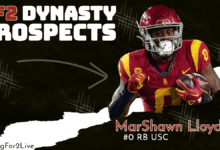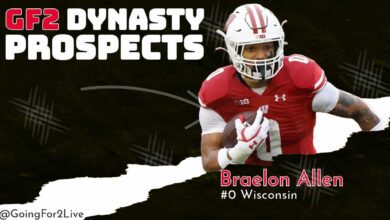
Fantasy football is a very crowded market. Not quite oversaturated, but it is close. There is only so much data out there, while the number of analysts grows exponentially. Everyone is getting smarter. This makes finding an edge in today’s game all the more important.
This led me to dive deep into red zone receiving data from last season, specifically targets and receptions. As I looked around the industry, not too many people go in-depth on the red zone, so I figured this might be my edge. But first, we need to talk about what exactly are red zone targets and receptions.
Pro Football Reference charts red zone targets as a target where the ball is snapped at the opponents’ 20-yard line and in. Pro Football Focus charts red zone targets as targets where the ball is snapped anywhere but the intended target is located at the opponents’ 20-yard line and in.
I prefer the way Pro Football Reference charts red zone data, as I present this scenario: Say the ball gets snapped on an offense’s 40-yard line. The quarterback drops back and throws the ball 41 yards to a receiver running a “go” route. The receiver catches the ball gets tackled immediately on the 19-yard line. This is considered a red zone target in PFF’s database despite the play having no chance of scoring, just the fact that it ended up in the red zone.

To this scenario, I propose this: What if the ball gets snapped on the offense’s 40-yard line and the quarterback hands it off to a running back. The back takes the ball 41 yards to the opponents 19-yard line. Shouldn’t this be counted as a red zone rush? The ball ended up in the red zone and the player had just as much of a chance to score as the receiver in the previous situation.
While PFF does excellent work and I am just a lowly blip on their fantasy radar, I believe this is one reason why they chart red zone data the wrong way. The red zone is a sacred place where the promised land lies just 20 yards away.
When we think of red zone data, we want to know what a player offers when the field is compact and they have to produce where they have limited space to work with. This is where scoring potential comes into play. We want players with big frames, strong verticals, or short area quickness. Players with a true connection with their quarterbacks, or an anemic offense that can’t run the ball successfully in the red zone.
So now that we are a couple hundred words into this article, let’s talk about the actual data.
I analyzed 80 players who saw at least 10 red zone targets in the 2017 season. This data was obtained from Pro Football Reference, where I charted the targets, receptions, yards, touchdowns, and PPR fantasy points per target and per catch in red zone and non-red zone situations.
Just for a baseline, these 80 players averaged 1.51 fantasy points per non-red zone target. So any time the ball was snapped that was before an opponents’ 20-yard line and the player was targeted, they received 1.51 fantasy points. If they caught that target, it was worth 2.35 fantasy points.
Let’s jump ahead to the red zone. Every time the ball was snapped inside the opponents’ 20-yard line, the pass catcher averaged 2.43 fantasy points per target. If they caught that red zone target, they averaged a whopping 4.53 fantasy points.
So basically a red zone target is worth almost a full point more, or 60 percent more than a non-red zone target. And a red zone reception is worth 2.1 points more, or 92 percent (!) more than a non-red zone reception.
Love our content? Check out the GoingFor2 Live Podcast Network!
So despite a squished field with less yardage potential, the sheer fact that the red zone is so close drives the value of a target and reception through the roof. This makes the fantasy assets with those higher red zone target share totals worth that much more than other assets.
Some of this may seem obvious, as touchdowns are worth the most in fantasy football. But having that actual value of a red zone target is huge for people that want an edge in the data.
Over the next few weeks, I’ll be digging deeper into this data to show players that are better than average, worse than average, and much, much more. Be sure to follow me on Twitter @jtaysmithFF to keep up to date on this series of articles and all things fantasy. Thanks for reading as always.
ATTN Dynasty Commissioners: Do you want to do something cool for your league? How about a 1-hour live show dedicated to YOUR league? Team-by-team breakdowns, rankings, and more. For details and to book a show, visit: GoingFor2.com/plp.





